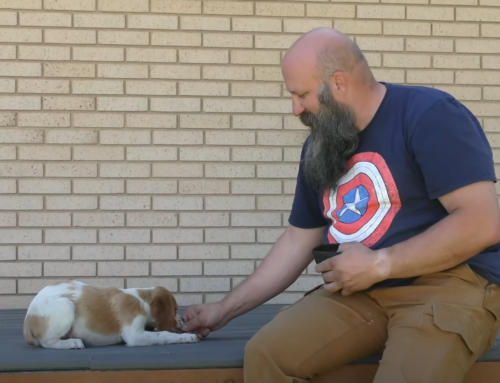So you want to teach your French Brittany a force fetch.
Step 1) Slap yourself and go back to teaching the motivational retrieve. You shouldn’t have to teach your dog a force fetch, and this isn’t a breed that responds well to force and compulsion
You still want to teach the force fetch?
Step 1) After slapping yourself or pinching your own ear or shocking your own neck (since that is what you want to do to this dog) Figure out where you went wrong teaching the motivational retrieve and go back and do it right
No I don’t have my own images to add to this post because I don’t teach a force fetch. Ever. Can I do it? Yes. But I won’t
If you insist on teaching a force fetch, I am very sorry for your French Brittany but here is how you can do it despite my advice to do it right instead
Teaching Your French Brittany Puppy the Forced Retrieve: A Comprehensive Guide
The French Brittany is a highly intelligent and energetic breed, known for their exceptional retrieving skills. Training your French Brittany puppy to perform a forced retrieve, also known as force fetch, is an essential skill that will not only strengthen your bond with your pup but also enhance their natural abilities. In this comprehensive article, we will guide you through the step-by-step process of teaching your French Brittany puppy the forced retrieve, including essential commands, necessary equipment, and how to overcome potential roadblocks.
Introduction to French Brittany Puppies and the Importance of Training
French Brittany puppies are renowned for their agility, stamina, and keen sense of smell. These traits make them excellent hunting companions, particularly in retrieving game. Training your French Brittany puppy from an early age is crucial to ensure they develop the skills and discipline required for a well-rounded and obedient dog. The forced retrieve is a key component of this training, as it teaches your pup to reliably retrieve items on command, regardless of their desire or interest in the object.
Step-by-Step Process of Teaching the Forced Retrieve
-
Establish a solid foundation: Before beginning the forced retrieve training, ensure your puppy has a strong understanding of basic obedience commands such as “sit,” “stay,” and “come.”
-
Introduce the “hold” command: Begin by teaching your puppy to hold an object, such as a training dummy, in their mouth. Place the object in their mouth, gently holding it in place, and use the command “hold.” Reward your puppy with praise and treats for successfully holding the object. Lets face it though the only reward force fetch trainers use is they stop causing the pain. When teaching the forced retrieve, trainers will introduce punishment for not holding the object or not holding it calmly or correctly. Punishment is often an ear pinch or shock collar or prong collar. Almost always with a dog tethered on a table where it can not get away.
-
Progress to picking up the object: Once your puppy can hold the object consistently, encourage them to pick it up off the ground. Place the dummy on the ground and use the “hold” command. Reward your puppy when they successfully pick up the object. And of course what this really means is punish your dog if it will not, and punish them until they comply and again they can not get away from you, the situation or the pressure.
-
Introduce light pressure: With your puppy successfully picking up the object, it’s time to introduce light pressure to simulate a forced retrieve. Gently pinch your puppy’s ear or apply slight pressure to their collar while giving the “hold” command. As soon as your puppy picks up the object, release the pressure and reward them.
-
Increase pressure gradually: Over time, gradually increase the pressure applied during the “hold” command until your puppy consistently picks up the object despite the pressure.
-
Add distance and distractions: Once your puppy is comfortable performing the forced retrieve under pressure, begin adding distance and distractions to challenge their skills further.
Essential Commands and Equipment
- Basic obedience commands: “sit,” “stay,” and “come”
- “Hold” command for teaching your puppy to hold an object in their mouth
- Training dummy or other suitable object for retrieving
- Optional: ear pinch or pressure on the collar for introducing pressure during training
Dealing with Potential Roadblocks
- If your puppy struggles to hold the object, try using a different object that may be more appealing or easier for them to grip.
- If your puppy becomes resistant to the pressure applied during training, take a step back and reduce the pressure to a level they are comfortable with before gradually increasing it again.
- Remember to keep training sessions short and positive to prevent your puppy from becoming overwhelmed or frustrated.
Tips and Tricks for Smooth Training
- Be patient and consistent with your training, as the forced retrieve can be challenging for some puppies to master.
- Always end training sessions on a positive note, ensuring your puppy feels successful and motivated to continue learning.
- Use high-value treats and enthusiastic praise to reward your puppy for their progress.
Benefits of Learning the Forced Retrieve- You can brag to your buddies that you taught a force fetch to a very soft dog. The force fetch is reliable and consistent because the dog is trying to avoid pain and punishment. They are motivated by fear. But it isn’t any fun for you or the dog.
Teaching your French Brittany puppy the forced retrieve offers numerous benefits for both you and your pup, including:
- Improved reliability and consistency in retrieving items on command
- Enhanced communication and understanding between you and your puppy
- Strengthened bond and trust through consistent and focused training
By following this comprehensive guide and dedicating time and patience to the training process, your French Brittany puppy will soon master the forced retrieve, providing you with a reliable and skilled companion for retrieving tasks and activities.





Leave A Comment